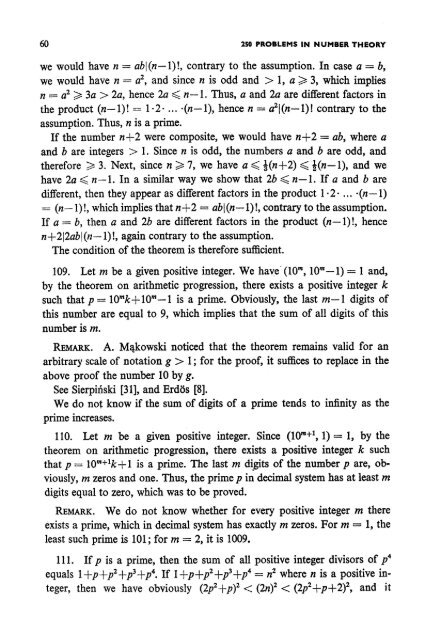250 Problems in Elementary Number Theory - Sierpinski (1970)
250 Problems in Elementary Number Theory - Sierpinski (1970)
250 Problems in Elementary Number Theory - Sierpinski (1970)
- No tags were found...
You also want an ePaper? Increase the reach of your titles
YUMPU automatically turns print PDFs into web optimized ePapers that Google loves.
60 <strong>250</strong> PROBLEMS IN NUMBER THEORYwe would have n = abICn-I)!, contrary to the assumption. In case a = b,we would have n = a 2 , and s<strong>in</strong>ce n is odd and > 1, a ~ 3, which impliesn = a 2 ~ 3a > 2a, hence 2a ~ n -1. Thus, a and 2a are different factors <strong>in</strong>the product (n-I)! = 1·2· ... ·(n-1), hence n = a21(n-1)! contrary to theassumption. Thus, n is a prime.If the number n+2 were composite, we would have n+2 = ab, where aand b are <strong>in</strong>tegers > 1. S<strong>in</strong>ce n is odd, the numbers a and b are odd, andtherefore ~ 3. Next, s<strong>in</strong>ce n ~ 7, we have a ~ 1(n+2) ~ len-I), and wehave 2a ~ n-1. In a similar way we show that 2b ~ n-I. If a and baredifferent, then they appear as different factors <strong>in</strong> the product 1· 2· ... ·(n-I)= (n-I)!, which implies that n+2 = abl(n-I)!, contrary to the assumption.If a = b, then a and 2b are different factors <strong>in</strong> the product (n-I)!, hencen+212abl(n-I)!, aga<strong>in</strong> contrary to the assumption.The condition of the theorem is therefore sufficient.109. Let m be a given positive <strong>in</strong>teger. We haye' (10 m , 10 m -I) = 1 and,by the theorem on arithmetic progression, there exists a positive <strong>in</strong>teger ksuch that p = 10 m k+ 10m-l is a prime. Obviously, the last m-l digits ofthis number are equal to 9, which implies that the sum of all digits of thisnumber is m.REMARK. A. M~kowski noticed that the theorem rema<strong>in</strong>s valid for anarbitrary scale of notation g > I; for the proof, it suffices to replace <strong>in</strong> theabove proof the number 10 by g.See Sierp<strong>in</strong>ski [31], and Erdos [8].We do not know if the sum of digits of a prime tends to <strong>in</strong>f<strong>in</strong>ity as theprime <strong>in</strong>creases.110. Let m be a given positive <strong>in</strong>teger. S<strong>in</strong>ce (10 m + 1 , 1) = 1, by thetheorem on arithmetic progression, there exists a positive <strong>in</strong>teger k suchthat p = lom+lk+l is a prime. The last m di.gits of the number p are, obviously,m zeros and one. Thus, the prime p <strong>in</strong> decimal system has at least mdigits equal to zero, which was to be proved.REMARK. We do not know whether for every positive <strong>in</strong>teger m thereexists a prime, which <strong>in</strong> decimal system has exactly m zeros. For m = 1, theleast such prime is 101; for m = 2, it is 1009.111. If p is a prime, then the sum of all positive <strong>in</strong>teger divisors of p4equals l+p+p2+p3+p4. If 1+p+p2+p3+p4 = n'Z where n is a positive <strong>in</strong>teger,then we have obviously (2p2+p)2 < (2n)2 < (2p2+p +2)2, and it


